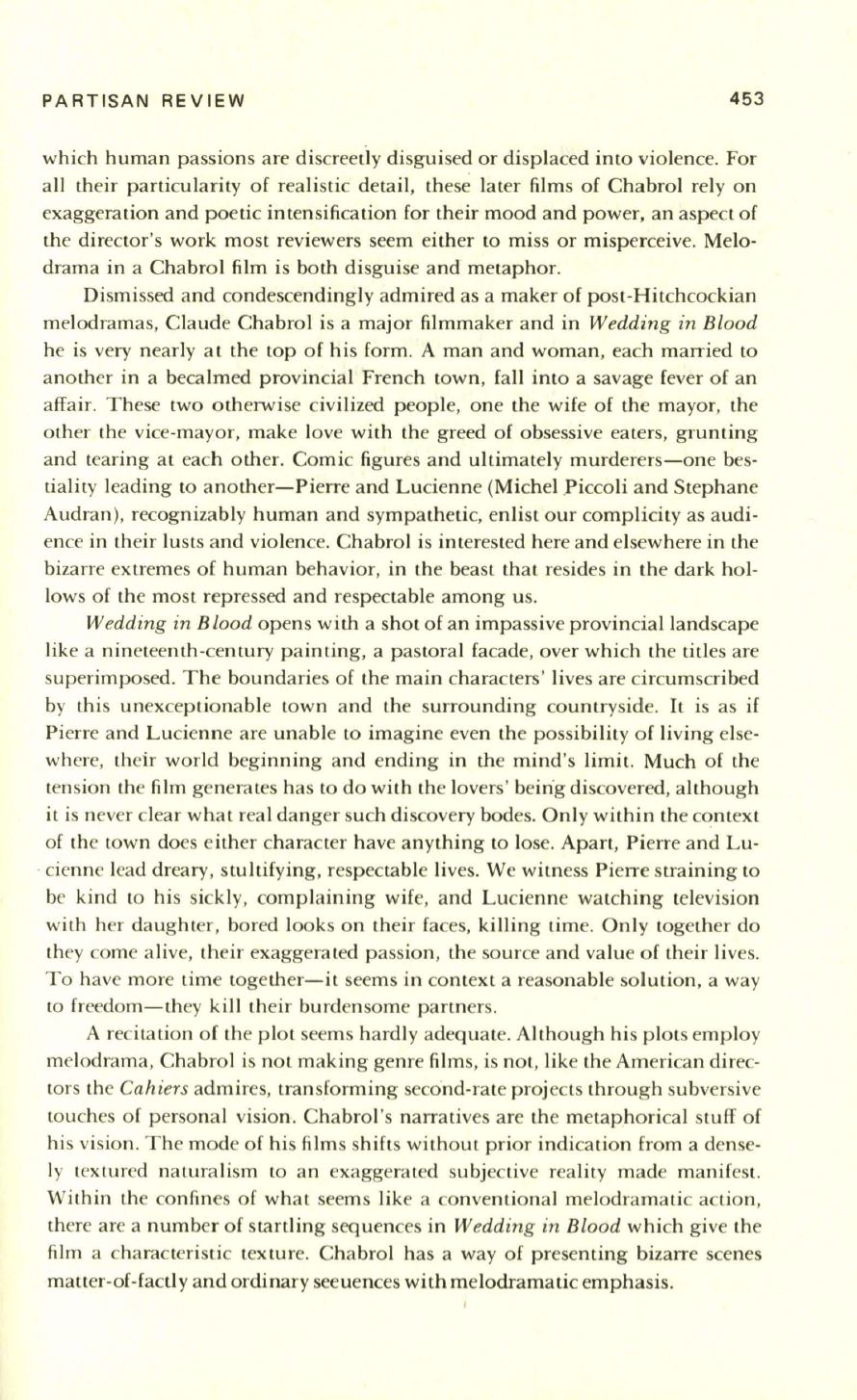
PARTISAN REVIEW
453
which human passions are discreetiy disguised or displaced into violence. For
all their particularity of realistic detail, these later films of Chabrol rely on
exaggeration and poetic intensification for their mood and power, an aspect of
the director's work most reviewers seem either to miss or misperceive. Melo–
drama in a Chabrol film is both disguise and metaphor.
Dismissed and condescendingly admired as a maker of post-Hitchcockian
melodramas, Claude Chabrol is a major filmmaker and in
Wedding in Blood
he is very nearly at the top of his form. A man and woman, each married to
another in a becalmed provincial French town, fall into a savage fever of an
affair. These two otherwise civilized people, one the wife of the mayor, the
other the vice-mayor, make love with the greed of obsessive eaters, grunting
and tearing at each other. Comic figures and ultimately murderers-one bes–
tiality leading to another-Pierre and Lucienne (Michel .Piccoli and Stephane
Audran), recognizably human and sympathetic, enlist our complicity as audi–
ence in their lusts and violence. Chabrol is interested here and elsewhere in the
bizarre extremes of human behavior, in the beast that resides in the dark hol–
lows of the most repressed and respectable among us.
Wedding in Blood
opens with a shot of an impassive provincial landscape
like a nineteenth-century painting, a pastoral facade, over which the titles are
superimposed. The boundaries of the main characters' lives are circumscribed
by this unexceptionable town and the surrounding countryside.
It
is as if
Pierre and Lucienne are unable to imagine even the possibility of living else–
where, their world beginning and ending in the mind's limit. Much of the
tension the film generates has to do with the lovers' being discovered, although
it is never clear what real danger such discovery bodes. Only within the context
of the town does either character have anything to lose. Apart, Pierre and Lu-
. cienne lead dreary, stultifying, respectable lives. We witness Pierre straining to
be kind to his sickly, complaining wife, and Lucienne watching television
with her daughter, bored looks on their faces, killing time. Only together do
they come alive, their exaggerated passion, the source and value of their lives.
To have more time together-it seems in context a reasonable solution, a way
to
freedom-they kill their burdensome partners.
A recitation of the plot seems hardly adequate. Although his plots employ
melodrama, Chabrol is not making genre films, is not, like the American direc–
tors the
Cahiers
admires, transforming second-rate projects through subversive
touches of personal vision. Chabrol's narratives are the metaphorical stuff of
his vision. The mode of his films shifts without prior indication from a dense–
ly textured naturalism to an exaggerated subjective reality made manifest.
Within the confines of what seems like a conventional melodramatic action,
there are a number of startling sequences in
Wedding in Blood
which give the
film a characteristic texture. Chabrol has a way of presenting bizarre scenes
maller-of-facti y and ordi nary seeuences wi th me lodrama tic emphasis.


